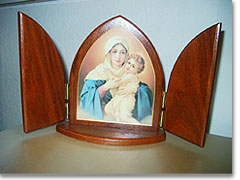 |
|
La imagen de la MTA, la Mater ter Admirabilis, difundida hoy en más de 90 paises The MTA picture, the picture of the Mother Thrice Admirable, today present and known in over 90 countries Das MTA-Bild, das Bild der Dreimal Wunderbaren Mutter, heute in über 90 Ländern bekannt und verbreitet |
|
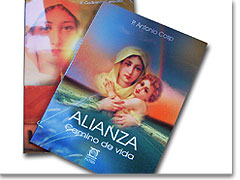 |
|
Se ve en Santuarios, Santuarios hogares, ermitas, afiches, libros, calcomanias... It can be seen in Shrines, home shrines, wayside shrines, on books, posters, stickers… Zu sehen in Heiligtümern und Hausheiligtümern, Bildstöcken, auf Postern, Büchern, T-Shirts, Aufklebern… Fotos: POS Fischer © 2005 |
|
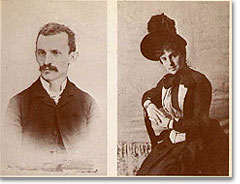 |
|
Carola Crosio con su marido Carola Crosio with her husband Carola Crosio mit ihrem Ehemann |
|
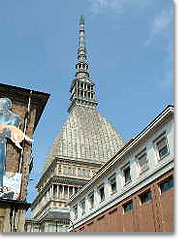 |
|
Torino Turin Turin |
|
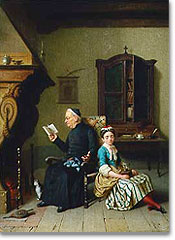 |
|
Obra de Luigi Crosio: La Biblia del curato Work of Luigi Crosio: The curate’s bible Werk von Luigi Crosio: Die Bibel des Kuraten |
|
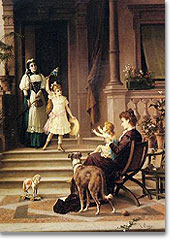 |
|
Otra obra: llegada de las hijas Other work: Return of the daughters Ein anderes Werk: Rückkehr der Töchter Fotos: Savage © 2005 |
|
|
ITALY, Fr. Michael Savage. Luigi Crosio often appears a little like a mirage, always slightly beyond the horizon, always just out of reach. That said my curiosity was still there, is there a story to be discovered and told?
With my own interest in matters to do with art I have always been curious about the identity of the man who painted the Mother Thrice Admirable picture originally entitled ‘Refuge of Sinners’. However he appears a little like a mirage, always slightly beyond the horizon, always just out of reach. My curiosity has also been slightly tempered by other considerations. In Schoenstatt the print originally presented to the Boys sodality back in 1915 has always been considered the most important image. It was through that print that the place and understanding of Mary and Christ within the movement found special expression. It was not the first choice of the boys, but Fr Kentenich during his prayer time in the shrine felt that it expressed quite clearly the special relationship between Christ and Mary and how we through the covenant of love are invited to become part of that relationship. Even when the original painting resurfaced in a shop in Switzerland during the 1960s it was decided to keep it in storage to be used for subsequent copies. Having the original while a significant find did not of itself bring us nearer the mystery the picture represents.
This is what worried me a little when I decided to search for Luigi Crosio the artist. Finding the information would not necessarily make the MTA image any more or less significant. God has a habit also of using people as his instruments and for his own purpose who are maybe unaware of the significance of their actions and creations. Their personal lives might perhaps even be contrary to the vision and spirit in which we now understand their works. Perhaps we should just thank God for the gift he has given us and quietly leave the rest to be forgotten. That said my curiosity was still there, is there a story to be discovered and told? Is there some element in the life of Crosio that resonates with the image of Jesus and Mary that he painted? Can we in Schoenstatt relate to the person as well as the image he produced for us?
Not too good an idea to go to Italy in August
A chance came this year to do some personal research in the city of Turin in northern Italy where Luigi worked and lived. It was the middle of August when I stepped off the train and made my way to a local hotel. I discovered quickly the search was going to be more difficult than I thought. Not just was Luigi very elusive, but the whole city of Turin seemed to have disappeared over the horizon. I discovered what Ferragosto meant for the Italians. Based around the feast of the Assumption the whole of Italy goes on holiday to the coast and the city was tangibly empty. I found myself walking down main avenues and boulevards which were empty of cars and people. Traffic lights blinked from red to green but there was no traffic. Museums were shut, as were the galleries and libraries and since the Italians like long holidays many were not due to reopen until a week after I was due back in Scotland. It was not looking promising so I asked the MTA for help, if there is a story to be told would She open a few doors. Over the next few days I discovered that some prayers are only answered if you put in a sizable amount of effort matched by an equivalent amount of frustration and worn shoe leather.
Torino, Via Po 43
A note in my possession reported the address of one of Luigi’s daughters Annette Crosio who in 1923 was reported as living at Via Po 43, so with a street map I found the Via Po. This was easy as it is one of the main shopping areas of the city. The address still exists but looking at the name plates I could see that while the house was obviously used by established Turin families the name Crosio has long disappeared from this area. Still it was start and helped me to get a sense of the space, the streets and the city that Luigi and his family would have known. I found a few book shops that were open and asked if there was any information or books that could include biographical details. One problem is that while Luigi seemed to be a successful professional painter in his day, his art has not translated well in the abstract conceptual world of the 20th and 21st centuries tastes. Most book shop assistants shrugged their shoulders but one directed me to a specialist shop that kept information on Piemont art and local history. A colourful if incoherent man came alive at my question. No he didn’t know anything about Luigi but he would see what he could find. After rummaging on a high shelf he produced a book with auction details for artists’ pictures dated 1999. Here we found my first success. A Crosio painting can still fetch a very good price. 1999 prices put an upper figure of 30,000,000 lire or just over £7000 a medium price for a painting of that type and period. There were still no biographical details but it was a start, and the man told me to come back tomorrow where he would dig out another book that might help.
Returning to the shop the following day the assistant had photocopied an entry that gave a brief paragraph on the Life of Luigi Crosio. It gave one or two points but essentially it was the sort of lives of artist entry that tell you the minimum about their work and nothing on their lives or who they were. The entry included a list of his paintings on display in the local Civic Museum for contemporary and modern art. I made my way there and finding it open eagerly looked to the 19th century section only to discovered that, yes, they did have these paintings but they were in storage. Another door seemed to slam shut in my face.
Searching continues
The following day I thought I might come at the problem from another angle. Turin has a museum dedicated to the history of the Italian independence and unification covering the years 1750 to 1945. It was open and a guided tour took us through the often bloody and politically troubled period of history. Luigi who was born in 1835 lived right through this time. His life also coincided with the lives of Don Bosco, Garibaldi and Cavour. While it gave nothing on his life it painted a broad image of the times he lived through. Turin was even briefly the capital of Italy for a few years.
Time was running out and while peering at the street map I became aware of the city cemetery. Would it be possible to find his grave? Unfortunately the pattern of the last few days continued, hopes sprung only to have the door slammed shut. The cemetery was old enough to have the grave of those who died in 1915, but of Luigi there was no sign. A computer search at the cemetery office could only find a Luigi Crosio who died in 1993, perhaps a relation but there was no way of telling. Even searching some of the older record books produced nothing and the woman serving me suggested that he might have been taken back to his home town which according to my notes was Alba which lies 30 miles south east of Turin. There was no time to go searching there.
Despite drawing a blank in so many areas I still sense the information is out there somewhere, just below the surface. My future plan is to see if I can access old Turin newspapers from 1915 to see if there is an obituary.
From one of the main art schools in the Piemont district
What follows is a synthesis of the information that I have been able to piece together. Being a work in progress it will hopefully change in the future as more information comes to light.
The standard entry for Luigi Crosio in the art biographies when you can find it states that he was born in Alba in 1835 and died in Turin in 1915. However an nearby town called Aqua a few miles north of Alba claims Luigi was born there and the Alba claim is erroneous despite being reported in many articles. He studied art at the Accademia Albertina di Belle Arte Torino, in the 1850s still one of the main art schools in the Piemont district. He was a talented professional and capable artist who made a respectable living out of his work. He was deliberately commercial, painting what the people were prepared to pay for. Crosio was not a cutting edge artist in the narrow way we understand today. Art for many people of his generation was a career where they were equally craftsmen as visionaries. The entry in the lives of the artists goes on to say that he specialised in genre pictures painting romantic 18th century scenes and portraits or period characters or Pompeian scenes, (recreating Roman era scenes from the city of Pompey before it’s destruction by Vesuvius). He had the Italian taste for opera and many images depict scenes from popular operas.
He was also listed as being a recognised lithographer or engraver and was involved in publications of books and images. This ties in with his contact and business dealings with the Kuenzili brothers in Switzerland through whom he produced and sold many of his paintings and works. In this aspect of his life in 1869 he is noted for doing the lithographic work on a portrait of Galileo, for a book called Galileo Galilei. This was translated from an original 1860 German book Galileo Galilei. Ein geschichtlicher Roman - Mathilde Raven. Leipzig. Brockhaus. 1860.
Painted in 1898 – the year Joseph Engling was born
My research has not revealed so far any information about his family life or when he married but it does seem that he had several daughters. Trawling through the internet one item appeared connected with Luigi’s daughter Carola Crosio. Her name appeared in an article about an Italian mathematician called Giuseppe Peano (1858; d. Turin, 1932). He was famous in both mathematics and logic. The article by Hubert Kennedy reports:
"On 21 July 1887 Peano married Carola Crosio. His wife was the daughter of Luigi Crosio, a successful Torinese genre painter of Pompeian and seventeenth-century scenes. Crosio’s daughter, Carola, shared some of his interests in the arts. Turin had a very good opera house at this time; the first performances of Puccini’s Manon Lescaut and La Bohème were given at the Royal Theater of Turin in 1893 and 1896, respectively. Mrs. Peano enjoyed opera, but Peano seems to have sometimes slept during a performance, his musical taste ran to lighter things."
Peano also regularly corresponded with the great English philosopher Bertrand Russell.
Moving closer to home and Crosio’s picture Refugium peccatorum which became the Mother Thrice Admirable picture most of our information comes from a letter dated 22 April 1966 from A. Hollman. Mr Hollman worked for many years as an employee of the Kuenzli brothers firm in Switzerland. In 1966 he was involved with the concluding work related to the winding up of the firm's business after it closed. Two years before (1964) the Swiss province of the Schoenstatt sisters had purchased the original painting along with the copy and printing rights. In the letter Mr Hollman wrote:
"The man who painted the picture Mater Ter Admirabilis (originally entitled Refugium Peccatorum) Luigi Crosio had painted a great deal for the Kuenzil Brothers, not only religious pictures abut also genre images, scenes from operas and so on. The correspondence from that period has as you would expect has not been kept; only those documents relating to the copyright, and declaration of transfer had been kept. From Luigi Crosio there exists a hand written and signed document dated ‘Turin 10th October 1898', by which he relinquished to the Kuenzil Bros the property and reproduction rights relating to the painting Refugium Peccatorium. The painting itself must have then been produced that same year.
The Kuenzil brothers with whom Crosio personally dealt with are long dead. However within the business it was known through word of mouth that the artist had used a daughter as a model for this and other Madonna paintings. I can remember years ago there was copyright claim by an imitator (the copyright claim happened years ago). The imitator, as often happens with such people left it to chance. You had to prove to him that he had copied from Crosio and not the other way round that Crosio had copied from him. The Kuenzil Bros were able to produce family photographs from Crosio which proved that Crosio’s daughter had acted as the model for the Madonna painting. ( I include with this letter an example of another Madonna painting from Crosio which shows the same face as used). Regarding the model for the child Jesus I don’t have any information."
Work in progress
I have found two letters from a Crosio daughter dated in 1923. She signed herself on one occasion as Annette Crosio, and in the other letter Anna Crosio. The address was Via Po 23. Whether she was the model or another sister I do not know. Crosio apparently had several daughters as Annette wrote from, "Figliuole" ( term in Italian for female children) of the deceased master. The last work Crosio completed for the Kuenzil bros was in 1911.
In Schoenstatt the MTA image is sometimes reported as belonging to the Nazarene school. I found no evidence of this. The Nazarene School has it’s roots in a German colony of artists in Rome as early as 1815. Born in 1835 Luigi is a much later generation and nothing points to him having had any contact with that movement. He seems to belong to the broader school of late 19th century realists and in style has more in common with the Pre-Raphaelite movement in England.
This is the limit of the information I have been able to track down but
as they say:
Watch this space.
If anyone is aware of any further lines of enquiry I would be glad to
hear from them.
List of Luigi Crosio painting in major collections
- The curate’s Bible. Maria Louisa Gabriella Queen of Spain. Maria Teresa of Savoy Princess of Lamballe.
- Turin Civic museum of modern and contemporary art.